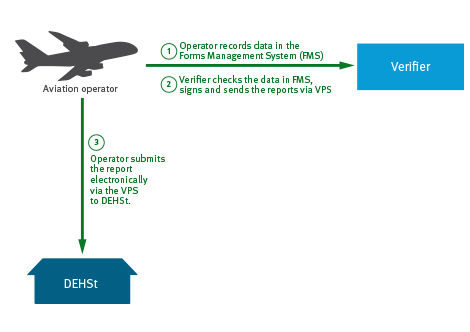CORSIA Reporting and Non-CO2 Effects
CORSIA reporting for German and European aircraft operators takes place together with the emissions report for the EU ETS 1 on 31/03 of the following year. By 30/11, DEHSt will inform the aircraft operators individually about the cancelation obligation under CORSIA resulting from their reporting.
Aircraft operators must also report on the non-CO2-effects caused by their flights for the first time by 31/03/2026. The necessary monitoring and reporting rules are currently being developed by the European Commission and are due to be published on 31/08/2024. There are no plans to impose a reporting obligation for the reported non-CO2 effects up to and including the 2027 reporting year.
Reporting Process
As an aircraft operator, you must determine your emissions annually on the basis of your monitoring plan and the Monitoring Regulation and create an emissions report. It must be checked by a verifier and then submitted to the competent authority by 31/03 of the following year. For aircraft operators regulated by Germany, this is the German Emissions Trading Authority (DEHSt) at the German Environment Agency. The CO2 emissions established for an aircraft operator for its flights during the previous calendar year are the basis for the "clearance", this is the surrender of emission allowances for the year in question.

Our Form Management System (FMS) is available to you for creating your emissions report. This server-based application implements the requirements for the content and structure of the reports as required in the Monitoring Regulation. Electronic communication between aircraft operators, verifiers and nd the German Emissions Trading Authority (DEHSt) takes place via the Virtual Mail Service (VPS).
We provide you with an XML interface for importing large volumes of data into the FMS.
Partial Import of Data (XML Interface)
If you already manage data that are relevant for the emissions report in your own databases or software programs, you can import them into the Forms Management System (FMS) via a data interface (the so-called XML interface) using the "partial import" function. For details on the requirements for a partial import, see the "Manuals and assistance" section below.
You can insert the following details into the emissions report using the partial import - for all reportable flights during the reporting year:
- the aircraft fleet
- the aerodrome pairs served and the number of flights
- the information about self-defined airfields (no ICAO airport code)
To the topic
XML Scheme for the Electronic Reporting for Aviation
Data Gaps
If your emissions report has data gaps, please specify them using the DEHSt "list of data gaps" template (see below). The completed template must be attached to the respective form in the FMS.
In addition to identifying the aircraft operator and the indication of the reporting year, the following details must be provided:
- Unit (e.g. aircraft or airport)
- Reason for the data gap
- Type of data gap
- Procedures for closing the data gap
To the topic
Improvement Reports
The Monitoring Regulation lays down two requirements related to improvement:
- Aircraft operators must take account of non-conformities and recommendations stated in the verification reports (Article 9 and Article 69(4)).
- Aircraft operators must check regularly on their own initiative in accordance with Articles 14(1) and 69(1), whether the monitoring methodology can be improved.
Improvement reports addressing recommendations for improvements, non-conformities and misstatements reported by the verifier must be submitted to the German Emissions Trading Authority (DEHSt) by 30/06 of the year in which the verification report is issued.
Manuals and Assistance
The German Emissions Trading Authority (DEHSt) provides different guides and user manuals relevant for reporting.








